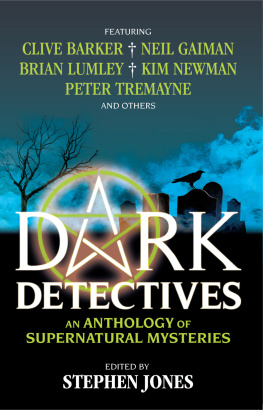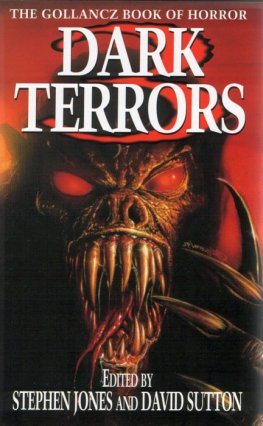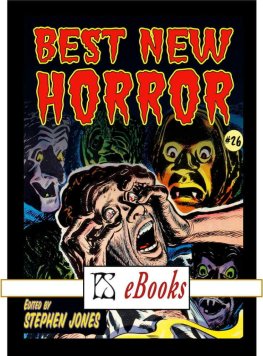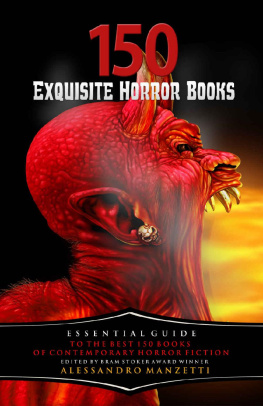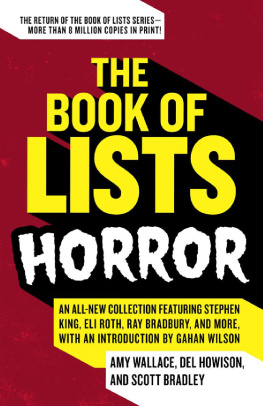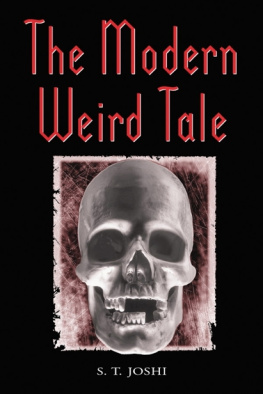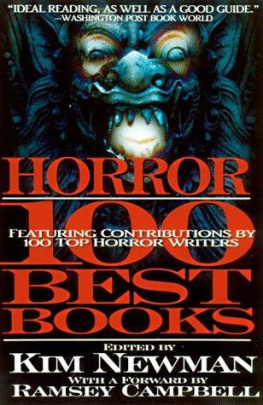Dark Terrors 5: The Gollancz Book of Horror
Edited By Stephen Jones & David Sutton
It is another dark and stormy night and for many of us, there is nothing more welcome than getting comfortable with a big book of stories specifically designed to induce the hairs on the back of our neck to stand on end and make our flesh creep.
The horror genre has a long and proud tradition of weighty tomes of terror, ranging from Dashiell Hammetts Creeps By Night, J.M. Parrish and John R. Crosslands The Mammoth Book of Thrillers, Ghosts and Mysteries, Dennis Wheatleys A Century of Horror and Christine Campbell Thompsons The Not at Night Omnibus, through Herbert A. Wise and Phyllis Frasers Great Tales of Terror and the Supernatural, Boris Karloffs And the Darkness Falls and August Derleths The Sleeping & the Dead, to more contemporary collections such as Kirby McCauleys Dark Forces, Douglas E. Winters Prime Evil and Al Sarrantonios 999: New Stories of Horror and Suspense.
The bigger the book, the wider the spectrum of fears which can be explored.
For more than a decade we have been fortunate to have the opportunity to compile a number of well-received volumes of contemporary horror. Within these various titles we have been able to present some of the best and most iconoclastic work by established authors in the genre, as well as introducing a number of new and talented writers to a wider readership. But no matter how many different authors we selected, no matter how much we convinced our publishers to allow us to massage the page-count and squeeze the budget, there were always stories we admired which we had to leave out when making our final selection.
When you receive literally hundreds of submissions, as we do when we begin compiling a volume, it is only ever possible to accept a small percentage of the best manuscripts and trust that those you have regretfully had to reject will find a home in some other anthology or magazine.
Which is why, when we were offered the opportunity to double the size of Dark Terrors, we jumped at the chance. A huge volume of modern horror and dark suspense, published on a regular basis, is exactly what the genre (and we hope the reader) wants. Now we would be able to include more stories by some of our favourite writers; we would be able to give more newcomers a professional forum for their fiction, and we would finally be able to incorporate more of those troublesome novellas, which fall between short story and novel length but which allow writers to flex their creative muscles.
Sure we would.
No sooner had we announced that we were reading than the manuscripts began flooding in. There is no better way than editing an anthology to make you realise that there are simply not enough markets for horror fiction available out there. Of course, much of what we received was unsuitable for one reason or another. But there were still more than enough outstanding stories to fill a big book. And another and another. In fact, a list of some of the authors we had to reject would make many other editors green with envy.
And in the end, despite having many more words to work with, we once again found ourselves massaging the page-count and squeezing the budget so that we could include just one more story by a favourite author or a talented newcomer.
Which is why we are so proud of this particular volume. As we have said before, we do not expect our readers to agree with all our choices, but we truly believe that this is as powerful and representative a selection of modern horror as we could compile.
So sit back and relax as the night draws in and the wind begins to howl outside. It is time to feel those nape hairs stiffen and the goosebumps tingle as you once again prepare to lose yourself within those dark terrors which follow
Stephen Jones and David Sutton
April, 2000
CHRISTOPHER FOWLER
At Home in the Pubs of Old London
The Museum Tavern, Museum Street, Bloomsbury
Despite its location diagonally opposite the British Museum, its steady turnover of listless Australian barstaff and its passing appraisal by tourists on quests for the British pub experience (comprising two sips from half a pint of bitter and one Salt n Vinegar flavoured crisp, nibbled and returned to its packet in horror), this drinking establishment retains the authentically seedy bookishness of Bloomsbury because its corners are usually occupied by half-cut proofreaders from nearby publishing houses. I love pubs like this one because so much about them remains constant in a sliding world: the smell of hops, the ebb of background conversation, muted light through coloured glass, china tap handles, mirrored walls, bars of oak and brass. Even the pieces of fake Victoriana, modelled on increasingly obsolete pub ornaments, become objects of curiosity in themselves.
At this time I was working in a comic shop, vending tales of fantastic kingdoms to whey-faced netheads who were incapable of saving a sandwich in a serviette, let alone an alien planet, and it was in this pub that I met Lesley. She was sitting with a group of glum-looking Gothic Gormenghast offcuts who were on their way to a book launch at the new-age smells n bells shop around the corner, and she was clearly unenchanted with the idea of joining them for a session of warm Liebfraumilch and crystal-gazing, because as each member of the group drifted off she found an excuse to stay on, and we ended up sitting together by ourselves. As she refolded her jacket a rhinestone pin dropped from the lapel, and I picked it up for her. The badge formed her initials L,L which made me think of Superman, because he had a history of falling for women with those initials, but I reminded myself that I was no superman, just a man who liked making friends in pubs. I asked her if shed had a good Christmas, she said no, I said I hadnt either and we just chatted from there. I told Lesley that I was something of an artist and would love to sketch her, and she tentatively agreed to sit for me at some point in the future.
* * *
The Worlds End, High Street, Camden Town
Its a funny pub, this one, because the interior brickwork makes it look sort of inside out, and theres a steady through-traffic of punters wherever you stand, so youre always in the way. Its not my kind of place, more a network of bars and clubs than a proper boozer. It used to be called the Mother Red Cap, after a witch who lived in Camden. There are still a few of her pals inhabiting the place if black eyeliner, purple lipstick and pointed boots make you a likely candidate for cauldron-stirring. A white stone statue of Britannia protrudes from the first floor of the building opposite, above a shoe shop, but I dont think anyone notices it, just as they dont know about the witch. Yet if you step inside the foyer of the Black Cap, a few doors further down, you can see the witch herself, painted on a tiled wall. Its funny how people miss so much of whats going on around them. I was beginning to think Sophie wouldnt show up, then I became convinced she had, and I had missed her.
Anyway, she finally appeared and we hit it off beautifully. She had tied back her long auburn hair so that it was out of her eyes, and I couldnt stop looking at her. Its never difficult to find new models; women are flattered by the thought of someone admiring their features. She half-smiled all the time, which was disconcerting at first, but after a while I enjoyed it because she looked like she was in on a secret that no one else shared. I had met her two days earlier in the coffee shop in Bermondsey where she was working, and she had suggested going for a drink, describing our meeting place to me as that pub in Camden near the shoe shop. The one thing Camden has, more than any other place in London, is shoe shops, hundreds of the bastards, so you can understand why I was worried.


